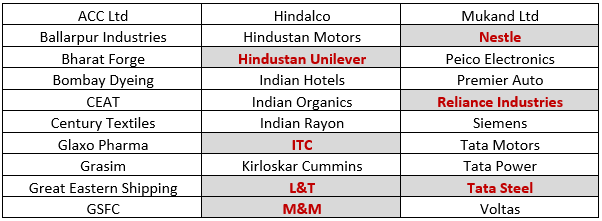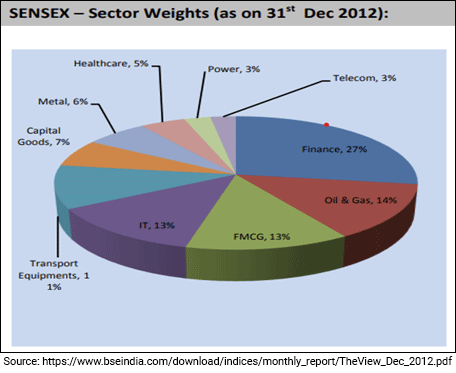- Home
- Views On News
- Sep 23, 2022 - 1986-2032: BSE 30 Companies - Then, Now and Beyond
1986-2032: BSE 30 Companies - Then, Now and Beyond

- 'It is not the strongest of the species that survives, nor the most intelligent that survives. It is the one that is most adaptable to change.' - Charles Darwin
What is one distinct similarity between the BSE Sensex and life?
Change.
Change is the only constant in life. Whether it's a human being or a company, the ability to adapt to change determines success or failure.
The index of the 30 largest stocks on the Bombay Stock Exchange (BSE) first came into being in 1986.
Over the years, the S&P BSE SENSEX has been India's most tracked bellwether index. It measures the performance of the 30 largest, most liquid, and financially sound companies across key sectors of the Indian economy.
But if we look back in time, there has been much tumult in arguably the most recognised market measure. This is a reminder of how benchmarks change over time, sometimes radically.
It's also a sign of how market leadership is volatile. Companies that do not evolve and change, fall aside.
Diamonds may be forever but bluechips, not so much.
Only 7 of the original 30 members of the BSE 30, since its launch in 1986, are still part of the Sensex.
Original List of Companies when the Sensex was first compiled in 1986

Peico Electronics? I am sure you are wondering, how you have never heard of that name if the company was part of the Sensex.
Peico Electronics & Electricals Ltd is none other than Philips India Ltd! A few years later, it named itself Philips India Limited.
The brand, which began with lighting, did well with TVs till the eighties, but lost out to nimbler competition.
A study by McKinsey found that the average lifespan of companies listed in the US Standard & Poor's 500, was 61 years in 1958. In 2017, this number was down to just 18 years.
And over the coming decades, it's likely to get even shorter. No wonder more and more companies are looking at being more agile.
In this article, we take a brief look at the stocks that have been part of the Sensex over the last three decades. We will try to decipher any learnings which indicates which sectors could dominate the Sensex over the next decade.
1992 - The End of the Textile Era
Textile stocks dominated the original list of Sensex companies in 1986. The textile sector had the highest weightage of 24%.
At one point, India was big in textiles. Many big business groups in India including the Tatas, Birlas, and Reliance started with textiles.
Till the 1980s, well-known Indian brands in business such as Sarabhais, Modis, and Mafatlals ruled the scene. But during the late 80's there was churn in the private sector. Many who could not cope with the change disappeared or became irrelevant.
At one point in time, companies owned by the Tatas & Birlas accounted for 45% of the marketcap of the Sensex.
Automobile companies such as Premier Automobile and Hindustan Motors seemed to be one of the best investments for shareholders.
In 1992, most companies were from the manufacturing sector: Cement, Textile, Metals, and Automobiles.
Not a single company from the financial services or the IT sector had made it to the coveted list in 1992.
BSE Sensex - List of Companies in 1992
| ACC Ltd | Gujarat Ambuja | NOCIL |
| Ballarpur Industries | Hindalco | Pfizer |
| Birla Corp | Hindustan Motors | Philips |
| Bombay Dyeing | Hindustan Unilever | Premier Auto |
| Castrol | Indian Rayon | Reliance Industries |
| CEAT | IPCL | Siemens |
| Century Textiles | ITC Ltd | Tata Motors |
| Colgate Palmolive | Kirloskar Cummins | Tata Steel |
| Glaxo Pharma | L&T | Voltas |
| GSFC | Mukand Ltd | Zenith Birla |
2002 - A Decade of Economic Liberalisation
The economic reforms of 1991 were a landmark event in India's history. Since then, the Indian economy and the stock markets have grown multi-fold.
But more interestingly, there was a major shift from the industrial sector to secondary and tertiary industries.
For instance, the 1991 reforms liberalised foreign investments and paved the way for private sector banks like ICICI Bank which found itself on the list along with State Bank of India.
The reforms transformed almost every sector from automobiles and electronics to telecom and media and entertainment.
Companies like Hindustan Motors and Premier Auto with their early mover advantage and in-depth knowledge of the Indian market were in a unique position to capitalise on the opportunities.
However, they failed to adapt with the fast-changing environment and faded away, never to return.
On the other hand, it would have been difficult to consider a media & entertainment company to be a part of the Sensex. However, Zee Telefilms (name changed to Zee Entertainment in 2007) made the cut and the entered the list in 2002.
The reforms proved to be a stepping stone for Indian companies that were in the early stages then. Now they have mushroomed into global entities.
Infosys and Satyam Computers (bought by Tech Mahindra) are classic examples. From nil in 1992 to 3 IT companies in 2002, it was another major shift in the Sensex during the decade.
BSE Sensex - List of Companies in 2022
| ACC Ltd | Gujarat Ambuja | Nestle |
| Bajaj Auto | Hindalco | NIIT |
| BHEL | Hindustan Unilever | Ranbaxy |
| BSES | HPCL | Reliance Industries |
| Castrol | ICICI Bank | Reliance Petroleum |
| CIPLA | Infosys | Satyam Computers |
| Colgate Palmolive | ITC | SBI |
| Dr Reddy's | L&T | Tata Motors |
| Glaxo Pharma | M&M | Tata Steel |
| Grasim | MTNL | Zee Telefilms |
2012 - The New Kid on the Block: Banking & Finance
The biggest sectoral shift between 2002 and 2012 was the increased prominence of banking and financial stocks in the Sensex.

By 2012, the HDFC twins had established their presence and the weightage of banking & financial stocks in the index had increased to 27%. This was the highest among all sectors.
That is a far cry from just two decades ago in 1992, when there was not a single financial stock in the Sensex.
Riding on the back of a golden decade of growth, IT stocks also increased their presence on the list.
Back then, the environment was very conducive for such growth. A global market was available, entry barriers were limited, as it was primarily a services game, and opportunities were still nascent.
And these IT companies with their highly skilled management, used the opportunity to the maximum.Wipro, NIIT, and TCS, joined Infosys, giving a boost to the sectoral weightage, increasing it to 13%.
Bharti Airtel which listed in 2001, also made its mark as the solo telecom company on the list.
Old timers, FMCG, oil & gas, metals, and pharmaceuticals continued to remain steady to make up the remainder of the sectors.
BSE Sensex - List of Companies in 2012
| Bajaj Auto | Hero MotoCorp | ONGC |
| Bharti Airtel | Hindalco | Reliance Industries |
| BHEL | Hindustan Unilever | SBI |
| Castrol | ICICI Bank | Sterlite Industries |
| CIPLA | Infosys | Sun Pharma |
| Coal India | ITC | Tata Motors |
| Dr Reddy's | Jindal Steel | Tata Power |
| GAIL | L&T | Tata Steel |
| HDFC | M&M | TCS |
| HDFC Bank | Maruti Suzuki | Wipro |
2022 - The Rise and Rise of Banking & Finance
In 1990, there were 75 banks and the size of the banking sector was just Rs 2.9 lakh crore. 32 years later, banking assets have multiplied 57 times to almost Rs 170 lakh crore.
Private banks and finance companies have played an instrumental role in this transition. They have brought new technology and products to the banking & finance space.
And this growth is reflected in the changing face of the Sensex. 9 of the 30 companies today belong to the banking and financial services industry.
In 2022, the banking and financial services industry has the highest weightage in the Sensex at 41%.
Since 2012, there have been five new additions to the Sensex, all from the financial sector - Axis Bank, Bajaj Finance, Bajaj Finserv, IndusInd Bank, and Kotak Mahindra Bank.
Even though, IT companies have underperformed over the last few quarters, the sector contributes over 15% of the Sensex.
Reliance Industries, being the most valued company on the bourses has the highest weightage for an individual stock at 12.7%.
The company has had a fabulous run since 2016 having created over Rs 10 lakh crore in wealth for its shareholders till date.
The pharma sector however has lost some ground declining from 5% in 2012 to 2.3% in 2022.
BSE Sensex - List of Companies in 2022
| Asian Paints | ICICI BANK | Power Grid |
| Axis Bank | IndusInd Bank | Reliance Ind |
| Bajaj Finance | Infosys | SBI |
| Bajaj Finserv | ITC | Sun Pharma |
| Bharti Airtel | Kotak Mahindra Bank | Tata Steel |
| Dr. Reddy's Lab | L&T | TCS |
| HCL Technologies | M&M | Tech Mahindra |
| HDFC | Maruti Suzuki | Titan |
| HDFC Bank | Nestle | Ultratech Cement |
| HUL | NTPC | Wipro |
2032 - The Sectors of the Future?
It's impossible for anyone to make stock predictions for the next day, let alone for 2032!
But a certain degree of predictability can be envisaged in a broader context of the best performing sectors.
And once you know which sectors could dominate the Sensex, it becomes easier. You just pick the leaders from the industry.
But picking a sector requires one to zoom out and take a macro view for the long term.
If we look back at the data of Sensex companies since 1986, we can establish that certain sectors tend to outperform in different periods of time.
Currently, the banking and finance sector dominates the Sensex list of companies, as opposed to textiles in the past or IT in a different era.
So, to identify the sector and possibly companies that could feature on the list, we must look at what is happening around us currently that could propel an industry to outperform the other sectors.
Sectors such as FMCG and Pharma are expected to remain at similar levels as their growth trajectory is constant.
In IT, there may be some consolidation with the industry gravitating around a handful of players. This could result in some lost ground for IT in terms of sectoral weightage.
But the leaders in FMCG, IT, and pharma could very likely remain on the BSE 30 list, albeit in a smaller proportion.
Over the next few years, one of the biggest themes expected to play out in India is manufacturing.
Over 30 years, the share of manufacturing in India's GDP has been stuck at around 15%.
But experts believe if manufacturing were to grow at 10% - the target set by the 'Make in India' campaign - its share would reach 25% in 2030-31. India would become the manufacturing shop floor of the world.
And there is a logic behind it. Never in Independent India has any government ever focused so strongly on manufacturing, be it the PLI schemes, labour reforms or Atmanirbhar Bharat.
Further, we have Apple, Samsung, IBM, and many other global giants all wanting to manufacture in India. This is creating a massive eco-system which will result in many more companies from across the world to follow.
If this happens, it will change the nature of our economy. Today, India's GDP is at over US$ 3 tn of which manufacturing contributes only US$ 450 bn.
India's GDP is expected to grow to US$ 5 tn by 2031. It's manufacturing that will be the key contributor to this rise. If its share to GDP reaches even 20% in 2031, that would be a mammoth US$ 1 tn!
Hence, it's highly likely that companies in this industry would be the biggest beneficiaries over the next decade.
The manufacturing sector is huge and includes many sub sectors such as capital goods, iron and steel, chemicals, consumables, transport equipment, and many more.
Let us take capital goods as an example.
If we look back at 2012, the share of capital goods companies in the Sensex was over 7%. Currently, it's at just 4%.
With a boost to the sector, there is a huge potential for these stocks. For instance, between 2003-2008, sales for capital goods companies grew on an average by 7 times but the marketcap of leaders like ABB and Siemens grew by an astonishing 18 times.
With this theme playing out, sub sectors such as these might be worth adding to your watch list. They might see a sharp increase in their weightage in the Sensex.
This manufacturing push is unlike any other. For the first time, a lot of MNC's are transferring their technology to their Indian counterparts. They are fully aware of the fact that India is on its way to become a manufacturing hub for the world.
Hence, it's not just domestic demand that they foresee to drive the Indian economy. These MNC's as well as domestic companies are pushing ahead for India to become an export hub for their international operations as they move away from China.
India's share in global merchandise trade stands at <2%. With all the focus on manufacturing, even if the share rose to 5%, the value creation for companies in this sector could be enormous.
Banking and finance will continue to remain prominent as it too will be another beneficiary of the manufacturing growth story.
Already corporate houses have announced capital expenditures of over Rs 8 lakh crore between 2022-2024.
Credit growth which was at about 5% three years ago has moved up to 14%. Hence, the banking and finance sector will continue to remain among the top sectors in the Sensex.
One more sector to watch out for is renewable energy. Leading companies are betting big on this business for the future.
Another possibility could be the Reliance Group hiving off its telecom and retail business into separate businesses. Both could emerge as key players in the Sensex.
Finally, we could see companies from sectors that are not currently present in the Sensex. We could see new segments like drones, semiconductors, or robotics just as they have found a place on international exchanges.
Just recently, there was news of IdeaForge Technology, India's largest drone maker backed by Qualcomm Inc, considering an initial public offering that could raise about US$ 125 m. The potential listing could happen as early as the first quarter of 2023.
Even some of the big online retailers and enablers like Flipkart and Ola could get listed and occupy a place in the BSE 30. Paytm already set the ball rolling with its listing in 2021.
All in all, it seems there will be a mix of the old and the new.
We live in exciting times...

Yazad Pavri
Cool Dad, Biker Boy, Terrible Dancer, Financial writer
I am a Batman fan who also does some financial writing in that order. Traded in my first stock in my pre-teen years, got an IIM tag if that matters, spent 15 years running my own NBFC and now here I am... Writing is my passion. Also, other than writing, I'm completely unemployable!
Equitymaster requests your view! Post a comment on "1986-2032: BSE 30 Companies - Then, Now and Beyond". Click here!
1 Responses to "1986-2032: BSE 30 Companies - Then, Now and Beyond"


Firuza Gheesta
Sep 28, 2022Excellent presentation